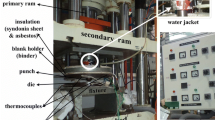Abstract
The alloy AA6111 has been chosen in many countries for automotive outerbody panels, but low ductility remains a major obstacle to competition with steel. Equal channel angular extrusion (ECAE) was used as a tool to produce fine-grained structures with enhanced ductility. Conventional grain sizes in the range of 9 µm to 50 µm were used to investigate the influence of severe plastic deformation (SPD) and heat treatment on mechanical properties of AA6111 sheet at room temperature. It has been found that SPD by ECAE followed by heat treatment leads to an increase in both strength and ductility, in addition to highr-value. The increase in mechanical properties was also significantly influenced by heat-treatment temperature at the final stage of sheet processing.
Similar content being viewed by others
References
I.J. Polmear, Light Alloys: Metallurgy of the Light Metals (London: Edward Arnold, 1995), p. 145.
David J. Lewis and Associates Pty. Ltd., Aluminium: Growth Opportunities in the Automotive Industry (Canberra: Australian Government Publishing Service, 1995), p. 62.
D. Li and A. Ghosh, “Tensile Deformation of Aluminum Alloys at Warm Forming Temperatures,” Materials Science and Engineering, A352 (2003), pp. 279–286.
L.P. Troeger and E.A. Starke, Jr., “Microstructural and Mechanical Characterization of a Superplasticity 6xxx Aluminum Alloy,” Materials Science and Engineering, A277 (2000), pp. 102–113.
R.P. Carreker, Jr. and W.R. Hibbard, Jr., “Tensile Deformation of Aluminum as a Function of Temperature, Strain Rate, and Grain Size,” Transactions AIME, (1957), pp. 1157–1163.
J.A. Chapman and D.V. Wilson, “The Room-Temperature Ductility of Fine-Grain Magnesium,” Journal of the Institute of Metals, 91 (1962–63), pp. 39–40.
R.P. Carreker Jr. and W.R. Hibbard Jr., “Tensile Deformation of High-Purity Copper as a Function of Temperature, Strain Rate, and Grain Size,” Acta Metallurgica, 1 (1953), pp. 654–663.
V.M. Segal et al., “Plastic Working of Metals by Simple Shear,” Russian Metallurgy, 1 (1981), pp. 99–105.
R.Z. Valiev, R.K. Islamgaliev, and I.V. Alexandrov, “Bulk Nanostructured Materials from Severe Plastic Deformation,” Progress in Materials Science, 45 (2000), pp. 103–189.
Y. Saito et al., “Improvement in the r-Value of Aluminum Strip by a Continuous Shear Deformation Process,” Scripta Materialia, 42 (2000), pp. 1139–1144.
J.-C. Lee et al., “Controlling the Texture of the Metal Strips via the Continuous Confined Strip Shearing (C2S2) Process,” Materials Research Bulletin, 36 (2001), pp. 997–1004.
C. Suryanarayana and C.C. Koch, “Nanostructures Materials,” Non-Equilibrium Processing of Materials, ed. C. Suryanarayana (Oxford: Elsevier Science Ltd., 1999), pp. 313–342.
R. Lapovok and P.F. Thomson, “Densification of Magnesium Particles by ECAE with a Back-Pressure,” Nanomaterials by Severe Plastic Deformation, ed. M. Zehetbauer and R.Z. Valiev (Weinheim: Wiley-VCH, 2004), pp. 551–557.
R. Lapovok and P.W.J. McKenzie, “Formation of Defects during Equal Channel Angular Extrusion,” Ultrafine Grained Materials III, ed. Y.T. Zhu et al. (Warrendale, PA: TMS, 2004), pp. 103–110.
M. Furukawa et al., “The Shearing Characteristics Associated with Equal-Channel Angular Pressing,” Materials Science and Engineering, A257 (1998), pp. 328–332.
A. Perovic et al., “Precipitation in Aluminium Alloys AA6111 and AA6016,” Scripta Materialia, 41 (7) (1999), pp. 703–708.
G. Burger et al., “Recrystallization in a 6000-Series Automotive Sheet Alloy during Solution Heat Treatment Practice,” Materials Science Forum, 217–222 (1996), pp. 471–478.
S. Ferrasse, “Grain Refinement Using Equal Channel Angular Extrusion In Bulk Sections of Copper 101 and Aluminum Alloys 3003 and 6061” (Master’s Thesis, Texas A&M University, May 1995).
Y. Iwahashi et al., “Principle of Equal Channel Angular Pressing for the Processing of Ultra-Fine Grained Materials,” Scripta Materialia, 35 (2) (1996), pp. 143–146.
S.M. Hirth et al., “Effect of Si on the Aging Behaviour and Formability of Aluminium Alloys Based on AA6016,” Materials Science and Engineering, A319–321 (2001), pp. 452–456.
W.B. Morrison, “The Effect of Grain Size on the Stress-Strain Relationship in Low-Carbon Steel,” Transactions of the ASM, 59 (1966), pp. 824–846.
B.A. Parker, “Formability and Microstructure,” Aluminum Alloys: Contemporary Research and Applications, ed. A.K. Vasudevan and R.D. Doherty (San Diego, CA: Academic Press, Inc., 1989), pp. 539–561.
S.S. Hecker and M.G. Stout, “Strain Hardening of Heavily Cold Worked Metals,” Deformation, Processing, and Structure, ed. G. Krauss (Metals Park, OH: American Society for Metals, 1984), pp. 1–46.
I.G. Palmer and G.C. Smith, “Fracture of Internally Oxidized Copper Alloys,” Oxide Dispersion Strengthening, ed. G.S. Ansell, T.D. Cooper, and F.V. Lenel (New York, NY: Gordon and Breach Science Publishers, Inc., 1968), pp. 253–290.
S.P. Keeler, “Ductility of Anisotropic Sheet Metals,” Ductility (Metals Park, OH: American Society for Metals, 1968), pp. 227–254.
A. Sherman, “Automotive Needs and Potential for Aluminum” (Presentation at the 1st International Light Metals Technology Conference, Brisbane, Australia, 18–20 September 2003).
N. Hansen, “Cold Deformation Microstructures,” Materials Science and Technology, 6 (1990), pp. 1039–1047.
M. Hatherly and W.B. Hutchinson, Introduction to Textures in Metals (London: Institute of Materials, 1979), p. 73.
Author information
Authors and Affiliations
Additional information
For more information, contact KiHo Rhee, Cooperative Research Centre for Cast Metals Manufacturing, School of Physics and Materials Engineering, Monash University; VIC, 3800, Australia; +61 3 9905 1967; fax +61 3 9905 4940; e-mail kiho.rhee@spme.monash.edu.au.
Rights and permissions
About this article
Cite this article
Rhee, K., Lapovok, R. & Thoms, P.F. The influence of severe plastic deformation on the mechanical properties of AA6111. JOM 57, 62–66 (2005). https://doi.org/10.1007/s11837-005-0099-9
Issue Date:
DOI: https://doi.org/10.1007/s11837-005-0099-9




